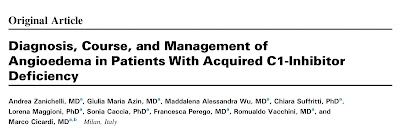Diagnosis, Course, and Management of Angioedema in Patients With Acquired C1-Inhibitor Deficiency
(J Allergy Clin Immunol Pract 2017)
BACKGROUND: Acquired angioedema due to C1-inhibitor deficiency (C1-INH-AAE) is a rare disease with no prevalence data or approved therapies.
OBJECTIVE: To report data on patients with C1-INH-AAE followed at Angioedema Center, Milan (from 1976 to 2015).
METHODS: Diagnostic criteria included history of recurrent angioedema without wheals; decreased C1-INH antigen levels and/or functional activity of C1-INH and C4 antigen less than 50% of normal; late symptom onset (>40 years); no family history of angioedema and C1-INH deficiency.
RESULTS: In total, 77 patients (58% females; median age, 70 years) were diagnosed with C1-INH-AAE and 675 patients with hereditary angioedema due to C1-INH deficiency (C1-INH-HAE) (1 patient with C1-INH-AAE/8.8 patients with C1-INH-HAE). Median age at diagnosis was 64 years. Median time between symptom onset and diagnosis was 2 years. Sixteen patients (21%) died since diagnosis, including 1 because of laryngeal edema.
Angioedema of the face was most common (N[ 63 [82%]), followed by abdomen (N[51 [66%]), peripheries (N[50 [65%]), and oral mucosa and/or glottis (N[42 [55%]). Forty-eight of 71 patients (68%) had autoantibodies to C1-INH. In total, 56 patients (70%) used on-demand treatment for angioedema including intravenous pdC1-INH 2000U(Berinert, CSL Behring, Marburg, Germany) (N 49) and/or subcutaneous icatibant 30 mg (Firazyr, Shire; Milano, Italy) (N[ 27). Eventually, 8 of 49
patients receiving pdC1-INH became nonresponsive; all had autoantibodies. Thirty-four patients received long-term prophylaxis with tranexamic acid (effective in 29) and 20 with androgens (effective in 8).
CONCLUSIONS: The incidence of C1-INH-AAE was 1 for every 8.8 patients with C1-INH-HAE. Thirty percent of the deaths were related to the disease. Treatments approved for C1-INH-HAE are effective in C1-INH-AAE, although with minimal differences.

Comentarios
Publicar un comentario